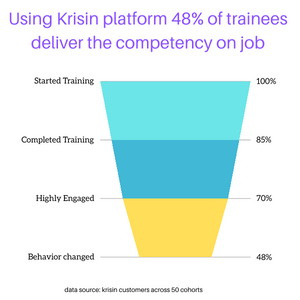In the dynamic landscape of the modern workplace, organizations invest significantly in Learning and Development (L&D) initiatives to stay competitive and ensure their workforce remains skilled and adaptable. However, the key to maximizing the impact of these programs lies in measuring their effectiveness. In this article, we'll explore various methods and metrics to gauge the success of your L&D efforts.
1. Kirkpatrick's Four-Level Model: A Holistic Approach to Evaluation
Theoretical knowledge is crucial, but how do employees feel about the training they receive? For instance, after implementing a new leadership development program, conduct surveys to measure participants' reactions. Ask about the relevance of the content, the effectiveness of delivery methods, and overall satisfaction with the training.
2. Phillips' ROI Model: Calculating the Bottom Line
Let's say your organization invested in a comprehensive sales training program. Calculate the ROI by comparing the increased revenue generated by the sales team post-training against the costs associated with designing, delivering, and evaluating the program.
3. Key Performance Indicators (KPIs): Aligning with Organizational Goals
If one of your organizational goals is to improve customer satisfaction, track KPIs such as customer feedback scores before and after implementing a customer service training program. A positive change in these scores could indicate the program's effectiveness.
4. Surveys and Feedback: Harnessing Participant Perspectives
Consider a scenario where an IT department implements a cybersecurity training program. Use surveys to collect feedback on the perceived effectiveness of the training in enhancing participants' awareness of cybersecurity threats and their ability to apply security measures.
5. Skills Assessments: From Knowledge Acquisition to Application
Imagine implementing a software proficiency training program. Administer pre-training assessments to gauge participants' existing skills. Post-training, assess their ability to navigate and use the software effectively, providing tangible evidence of skill development.
6. Performance Reviews: Connecting Training to Job Performance
Suppose your organization conducted a project management training program. During performance reviews, assess how well employees are applying project management principles in their roles. This direct connection between training and job performance is essential for evaluating effectiveness.
7. Learning Analytics: Data-Driven Insights for Continuous Improvement
Analyze LMS data to identify trends. For instance, if completion rates are consistently higher for interactive e-learning modules than traditional lectures, consider expanding the use of interactive content for future training initiatives based on this data-driven insight.
8. Cost-Effectiveness Analysis: Balancing Investment and Returns
Consider a scenario where your organization invested in leadership training. Compare the costs of the program to the benefits, such as increased employee retention and reduced turnover costs. This analysis helps determine whether the investment aligns with the organization's financial goals.
9. Employee Engagement and Satisfaction: The Heartbeat of Success
After implementing a diversity and inclusion training program, measure changes in employee engagement through surveys. Assess whether employees feel more included and satisfied, as this positive shift in sentiment is indicative of the program's success.
10. On-the-Job Observations: Seeing Skills in Action
If you introduced a communication skills training program, conduct on-the-job observations to witness employees applying effective communication techniques in meetings or collaborative projects. These observations provide firsthand evidence of skill application.
Conclusion:
Measuring the effectiveness of Learning and Development programs is not a one-size-fits-all endeavor. By combining these diverse methods and metrics with real-world examples, organizations can create a comprehensive evaluation framework that aligns with their unique goals and objectives. Continuous assessment and feedback ensure that L&D initiatives evolve alongside the ever-changing needs of the workforce, unlocking the full potential of both individuals and the organization as a whole.
.png?width=300&height=50&name=krisin_logo_-_new-removebg-preview%20(1).png)
